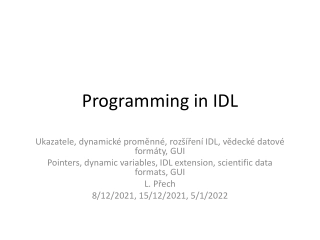
Icy-Based Program Writing Guide for N.IF Navigation Facility - April 2023
Discover the steps involved in writing an Icy-based program for the N.IF Navigation and Ancillary Information Facility in April 2023. Learn about understanding geometry problems, selecting SPICE kernels, writing the program, and more.
Download Presentation

Please find below an Image/Link to download the presentation.
The content on the website is provided AS IS for your information and personal use only. It may not be sold, licensed, or shared on other websites without obtaining consent from the author. If you encounter any issues during the download, it is possible that the publisher has removed the file from their server.
You are allowed to download the files provided on this website for personal or commercial use, subject to the condition that they are used lawfully. All files are the property of their respective owners.
The content on the website is provided AS IS for your information and personal use only. It may not be sold, licensed, or shared on other websites without obtaining consent from the author.
E N D
Presentation Transcript
N IF Navigation and Ancillary Information Facility Writing an Icy (IDL) Based Program April 2023
N IF Viewing This Tutorial Navigation and Ancillary Information Facility Undefined variables are displayed in red Results are displayed in blue Please read the tutorial Preparing for Programming prior to attempting the exercise contained in this tutorial. Writing an Icy-based program 2
N IF Introduction Navigation and Ancillary Information Facility First, let's go over the important steps in the process of writing an Icy-based program and putting it to work: Understand the geometry problem. Identify the set of SPICE kernels that contain the data needed to perform the computation. Select the SPICE APIs needed to compute the quantities of interest. Write and compile the program. Get actual kernel files and verify that they contain the data needed to support the computation for the time(s) of interest. Run the program. To illustrate these steps, let's write a program that computes the apparent intersection of the boresight ray of a given CASSINI science instrument with the surface of a given Saturnian satellite. The program will compute: Planetocentric and planetodetic (geodetic) latitudes and longitudes of the intercept point. Range from spacecraft to intercept point. Illumination angles (phase, solar incidence, and emission) at the intercept point. Writing an Icy-based program 3
N IF Observation geometry Navigation and Ancillary Information Facility We want the boresight intercept on the surface, range from s/c to intercept, and illumination angles at the intercept point. When? surface normal time (UTC, TDB or TT) emission angle On what object? satnm solar incidence angle In what frame? fixref Phase angle For which instrument? instnm For what spacecraft? scnm setupf Using what model? Writing an Icy-based program 4
N IF Needed Data Navigation and Ancillary Information Facility Time transformation kernels Orientation models emission angle surface normal solar incidence angle Instrument descriptions phase angle Shapes of satellites, planets Ephemerides for spacecraft, Saturn barycenter and satellites. sun Writing an Icy-based program 5
N IF Which Kernels are Needed? Navigation and Ancillary Information Facility Data required to compute vectors, rotations and other parameters shown in the picture are stored in the SPICE kernels listed below. Note: these kernels have been selected to support this presentation; they should not be assumed to be appropriate for user applications. Parameter Kernel Type File name ----------------------- -------------- ------------ time conversions generic LSK naif0009.tls CASSINI SCLK cas00084.tsc satellite orientation CASSINI PCK cpck05Mar2004.tpc satellite shape CASSINI PCK cpck05Mar2004.tpc satellite position planet/sat ephemeris SPK 020514_SE_SAT105.bsp planet barycenter position planet SPK 981005_PLTEPH-DE405S.bsp spacecraft position spacecraft SPK 030201AP_SK_SM546_T45.bsp spacecraft orientation spacecraft CK 04135_04171pc_psiv2.bc instrument alignment CASSINI FK cas_v37.tf instrument boresight Instrument IK cas_iss_v09.ti Writing an Icy-based program 6
N IF Load kernels Navigation and Ancillary Information Facility The easiest and most flexible way to make these kernels available to the program is via cspice_furnsh. For this example we make a setup file (also called a metakernel or furnsh kernel ) containing a list of kernels to be loaded: Note: these kernels have been selected to support this presentation; they should not be assumed to be appropriate for user applications. \begindata KERNELS_TO_LOAD = ('naif0009.tls', 'cas00084.tsc', 'cpck05Mar2004.tpc', '020514_SE_SAT105.bsp', '981005_PLTEPH-DE405S.bsp', '030201AP_SK_SM546_T45.bsp', '04135_04171pc_psiv2.bc', 'cas_v37.tf', 'cas_iss_v09.ti') \begintext and we make the program prompt for the name of this setup file: read, setupf, PROMPT='Enter setup file name > ' cspice_furnsh, setupf Writing an Icy-based program 7
N IF Programming Solution Navigation and Ancillary Information Facility Prompt for setup file ( metakernel ) name; load kernels specified via setup file. (Done on previous chart.) Prompt for user inputs required to completely specify problem. Obtain further inputs required by geometry routines via Icy calls. Compute the intersection of the boresight direction ray with the surface of the satellite, presented as a triaxial ellipsoid. If there is an intersection, Convert Cartesian coordinates of the intersection point to planetocentric latitudinal and planetodetic coordinates Compute spacecraft-to-intercept point range Find the illumination angles (phase, solar incidence, and emission) at the intercept point Display the results. We discuss the geometric portion of the problem first. Writing an Icy-based program 8
N IF Compute surface intercept Navigation and Ancillary Information Facility Compute the intercept point (point) of the boresight vector (insite) specified in the instrument frame (iframe) of the instrument mounted on the spacecraft (scnm) with the surface of the satellite (satnm) at the TDB time of interest (et) in the satellite s body-fixed frame (fixref). This call also returns the light-time corrected epoch at the intercept point (trgepc), the spacecraft-to-intercept point vector (srfvec), and a flag indicating whether the intercept was found (found). We use "converged Newtonian" light time plus stellar aberration corrections to produce the most accurate surface intercept solution possible. We model the surface of the satellite as an ellipsoid. cspice_sincpt, 'Ellipsoid', satnm, et, fixref, 'CN+S', scnm, iframe, $ insite, point, trgepc, srfvec, found The range we want is obtained from the outputs of cspice_sincpt. These outputs are defined only if a surface intercept is found. Iffoundis true, the spacecraft-to-surface intercept range is the norm of the output argument srfvec. Units are km. We use the Icy function cspice_vnorm to obtain the norm: cspice_vnorm( srfvec ) We'll write out the range data along with the other program results. Writing an Icy-based program 9
N IF Compute Lat/Lon and Illumination Angles Navigation and Ancillary Information Facility Compute the planetocentric latitude (pclat) and longitude (pclon), as well as the planetodetic latitude (pdlat) and longitude (pdlon) of the intersection point. if ( found ) then begin cspice_reclat, point, r, pclon, pclat ;; Let re, rp, and f be the satellite's longer equatorial ;; radius, polar radius, and flattening factor. re = radii[0] rp = radii[2] f = ( re rp ) / re; cspice_recgeo, point, re, f, pdlon, pdlat, alt The illumination angles we want are the outputs of cspice_ilumin. Units are radians. cspice_ilumin, 'Ellipsoid', satnm, et, fixref, 'CN+S', scnm, $ point, trgepc, srfvec, phase, solar, emissn Writing an Icy-based program 10
N IF Geometry Calculations: Summary Navigation and Ancillary Information Facility ;; Compute the boresight ray intersection with the surface of the ;; target body. cspice_sincpt, 'Ellipsoid', satnm, et, fixref, 'CN+S', scnm, $ iframe, insite, point, trgepc, srfvec, found ;; If an intercept is found, compute planetocentric and planetodetic ;; latitude and longitude of the point. if ( found ) then begin cspice_reclat, point, r, pclon, pclat ;; Let re, rp, and f be the satellite's longer equatorial ;; radius, polar radius, and flattening factor. re = radii[0] rp = radii[2] f = ( re rp ) / re; cspice_recgeo, point, re, f, pdlon, pdlat, alt ;; Compute illumination angles at the surface point. cspice_ilumin, 'Ellipsoid', satnm, et, fixref, 'CN+S', scnm, $ point, trgepc, srfvec, phase, solar, emissn ... endif else begin ... Writing an Icy-based program 11
N IF Get inputs - 1 Navigation and Ancillary Information Facility The code above used quite a few inputs that we don't have yet: TDB epoch of interest ( et ); satellite and s/c names (satnm, scnm); satellite body-fixed frame name (fixref); satellite ellipsoid radii (radii); instrument fixed frame name (iframe); instrument boresight vector in the instrument frame (insite); Some of these values are user inputs; others can be obtained via Icy calls once the required kernels have been loaded. Let's prompt for the satellite name (satnm), satellite frame name (fixref), spacecraft name (scnm), instrument name (instnm) and time of interest (time): read, satnm , PROMPT='Enter satellite name > ' read, fixref, PROMPT='Enter satellite frame > ' read, scnm , PROMPT='Enter spacecraft name > ' read, instnm, PROMPT='Enter instrument name > ' read, time , PROMPT='Enter time > ' Writing an Icy-based program 12
N IF Get Inputs - 2 Navigation and Ancillary Information Facility Then we can get the rest of the inputs from Icy calls: To get the TDB epoch (et) from the user-supplied time string (which may refer to the UTC, TDB or TT time systems): cspice_str2et, time, et To get the satellite s ellipsoid radii (radii): cspice_bodvrd, satnm, "RADII", 3, radii To get the instrument boresight direction (insite) and the name of the instrument frame (iframe) in which it is defined: cspice_getfvn, instnm, ROOM, shape, iframe, insite, bundry Writing an Icy-based program 13
N IF Getting inputs: summary Navigation and Ancillary Information Facility ;; Prompt for the user-supplied inputs for our program read, setupf, PROMPT='Enter setup file name > ' cspice_furnsh, setupf read, satnm , PROMPT='Enter satellite name > ' read, fixref, PROMPT='Enter satellite frame > ' read, scnm , PROMPT='Enter spacecraft name > ' read, instnm, PROMPT='Enter instrument name > ' read, time , PROMPT='Enter time > ' ;; Get the epoch corresponding to the input time: cspice_str2et, time, et ;; Get the radii of the satellite. cspice_bodvrd, satnm, "RADII", 3, radii ;; Get the instrument boresight and frame name. cspice_getfvn, instnm, ROOM, shape, iframe, insite, bundry Writing an Icy-based program 14
N IF Display results Navigation and Ancillary Information Facility ;; Display results. Convert angles from radians to degrees for output. print print, 'Intercept planetocentric longitude (deg): ', $ cspice_dpr()*pclon print, 'Intercept planetocentric latitude (deg): ', $ cspice_dpr()*pclat print, 'Intercept planetodetic longitude (deg): ', $ cspice_dpr()*pdlon print, 'Intercept planetodetic latitude (deg): ', $ cspice_dpr()*pdlat print, 'Range from spacecraft to intercept point (km): ', $ cspice_vnorm(srfvec) print, 'Intercept phase angle (deg): ', $ cspice_dpr()*phase print, 'Intercept solar incidence angle (deg): ', $ cspice_dpr()*solar print, 'Intercept emission angle (deg): ', $ cspice_dpr()*emissn endif else begin print, 'No intercept point found at ' + time endelse END Writing an Icy-based program 15
N IF Complete the program Navigation and Ancillary Information Facility To finish up the program we need to declare the variables we've used. We'll highlight techniques used by NAIF programmers Add remaining IDL code required to make a syntactically valid program PRO PROG_GEOMETRY ROOM = 10L setupf = '' satnm = '' fixref = '' scnm = '' instnm = '' time = '' R2D = cspice_dpr() Writing an Icy-based program 16
N IF Complete source code - 1 Navigation and Ancillary Information Facility ;; Prompt for the user-supplied inputs for our program. read, setupf, PROMPT='Enter setup file name > ' cspice_furnsh, setupf read, satnm , PROMPT='Enter satellite name > ' read, fixref, PROMPT='Enter satellite frame > ' read, scnm , PROMPT='Enter spacecraft name > ' read, instnm, PROMPT='Enter instrument name > ' read, time , PROMPT='Enter time > ' ;; Get the epoch corresponding to the input time: cspice_str2et, time, et ;; Get the radii of the satellite. cspice_bodvrd, satnm, 'RADII', 3, radii ;; Get the instrument boresight and frame name. cspice_getfvn, instnm, ROOM, shape, iframe, insite, bundry Writing an Icy-based program 17
N IF Complete source code - 2 Navigation and Ancillary Information Facility ;; Compute the boresight ray intersection with the surface of the ;; target body. cspice_sincpt, 'Ellipsoid', satnm, et, fixref, 'CN+S', scnm, $ iframe, insite, point, trgepc, srfvec, found ;; If an intercept is found, compute planetocentric and planetodetic ;; latitude and longitude of the point. if ( found ) then begin cspice_reclat, point, r, pclon, pclat ;; Let re, rp, and f be the satellite's longer equatorial ;; radius, polar radius, and flattening factor. re = radii[0] rp = radii[2] f = ( re - rp ) / re cspice_recgeo, point, re, f, pdlon, pdlat, alt ;; Compute illumination angles at the surface point. cspice_ilumin, 'Ellipsoid', satnm, et, fixref, 'CN+S', scnm, $ point, trgepc, srfvec, phase, solar, emissn ;; Display results. Convert angles from radians to degrees ;; for output. print print, 'Intercept planetocentric longitude (deg): ', $ R2D*pclon Writing an Icy-based program 18
N IF Complete source code - 3 Navigation and Ancillary Information Facility print, 'Intercept planetocentric latitude (deg): ', $ R2D*pclat print, 'Intercept planetodetic longitude (deg): ', $ R2D*pdlon print, 'Intercept planetodetic latitude (deg): ', $ R2D*pdlat print, 'Range from spacecraft to intercept point (km): ', $ cspice_vnorm(srfvec) print, 'Intercept phase angle (deg): ', $ R2D*phase print, 'Intercept solar incidence angle (deg): ', $ R2D*solar print, 'Intercept emission angle (deg): ', $ R2D*emissn endif else begin print, 'No intercept point found at ' + time endelse ;; Unload the kernels and clear the kernel pool cspice_kclear END Writing an Icy-based program 19
N IF Compile the program - 1 Navigation and Ancillary Information Facility Though IDL functions in a manner similar to interpreted languages, it does compile source files to a binary form. Ensure that both the Icy Toolkit, and an IDL installation are properly installed. IDL must load the Icy DLM, icy.dlm/icy.so(dll) to compile those scripts containing Icy calls. IDL loads DLMs from default locations and from the current directory when the user ran IDL. The user may also explicitly load a DLM with the dlm_register command. Now compile the code. Writing an Icy-based program 20
N IF Compile the program - 2 Navigation and Ancillary Information Facility Terminal Window IDL> .compile prog_geometry.pro % Compiled module: PROG_GEOMETRY. Writing an Icy-based program 21
N IF Running the program Navigation and Ancillary Information Facility It looks like we have everything taken care of: We have all necessary kernels We made a setup file (metakernel) pointing to them We wrote the program We compiled the program Let's run it. Writing an Icy-based program 22
N IF Running the program Navigation and Ancillary Information Facility Terminal Window IDL> Enter setup file name > setup.ker Enter satellite name > PHOEBE Enter satellite frame > IAU_PHOEBE Enter spacecraft name > CASSINI Enter instrument name > CASSINI_ISS_NAC Enter time > 2004 jun 11 19:32:00 prog_geometry Intercept planetocentric longitude (deg): 39.843719 Intercept planetocentric latitude (deg): 4.1958778 Intercept planetodetic longitude (deg): 39.843719 Intercept planetodetic latitude (deg): 5.0480106 Range from spacecraft to intercept point (km): 2089.1697 Intercept phase angle (deg): 28.139479 Intercept solar incidence angle (deg): 18.247220 Intercept emission angle (deg): 17.858309 Writing an Icy-based program 23
N IF Backup Navigation and Ancillary Information Facility Latitude definitions: Planetocentric latitude of a point P: angle between segment from origin to point and x-y plane (red arc in diagram). Planetodetic latitude of a point P: angle between x-y plane and extension of ellipsoid normal vector N that connects x-y plane and P (blue arc in diagram). P N z-axis Reference ellipsoid Planetocentric latitude Planetodetic latitude O x-y plane Writing an Icy-based program 24






















